2017 HYUNDAI TUCSON LIMITED service
[x] Cancel search: servicePage 537 of 642
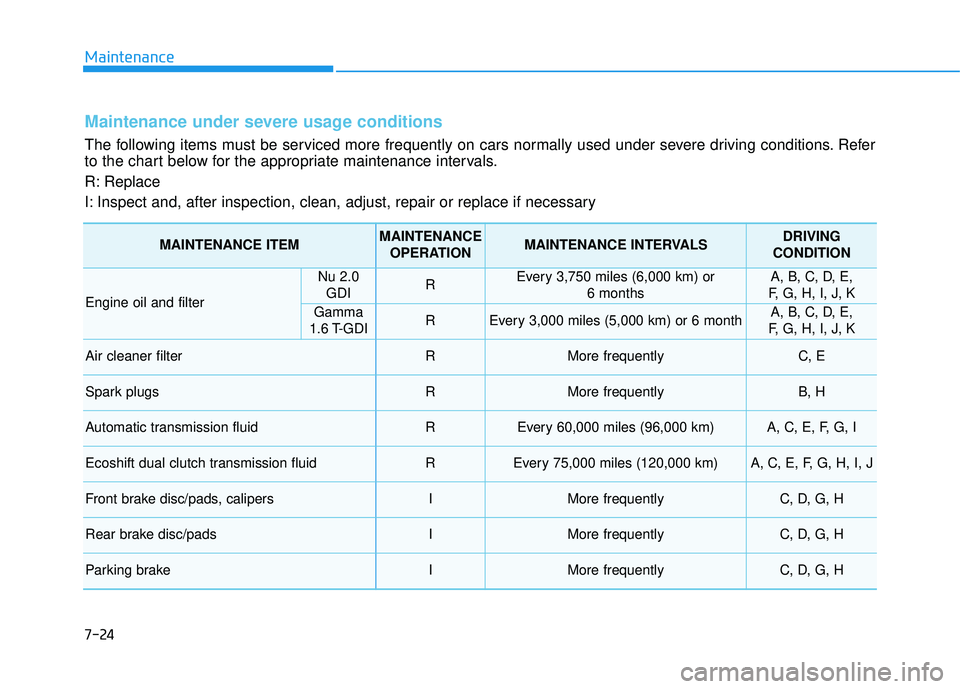
7-24
Maintenance
Maintenance under severe usage conditions
The following items must be serviced more frequently on cars normally used under severe driving conditions. Refer
to the chart below for the appropriate maintenance intervals.
R: Replace
I: Inspect and, after inspection, clean, adjust, repair or replace if necessary
MAINTENANCE ITEMMAINTENANCEOPERATIONMAINTENANCE INTERVALSDRIVING
CONDITION
Engine oil and filter
Nu 2.0 GDIREvery 3,750 miles (6,000 km) or 6 monthsA, B, C, D, E,
F, G, H, I, J, K
Gamma
1.6 T-GDIREvery 3,000 miles (5,000 km) or 6 monthA, B, C, D, E,
F, G, H, I, J, K
Air cleaner filterRMore frequentlyC, E
Spark plugsRMore frequentlyB, H
Automatic transmission fluidREvery 60,000 miles (96,000 km) A, C, E, F, G, I
Ecoshift dual clutch transmission fluidREvery 75,000 miles (120,000 km)A, C, E, F, G, H, I, J
Front brake disc/pads, calipersIMore frequentlyC, D, G, H
Rear brake disc/padsIMore frequentlyC, D, G, H
Parking brakeIMore frequentlyC, D, G, H
Page 559 of 642
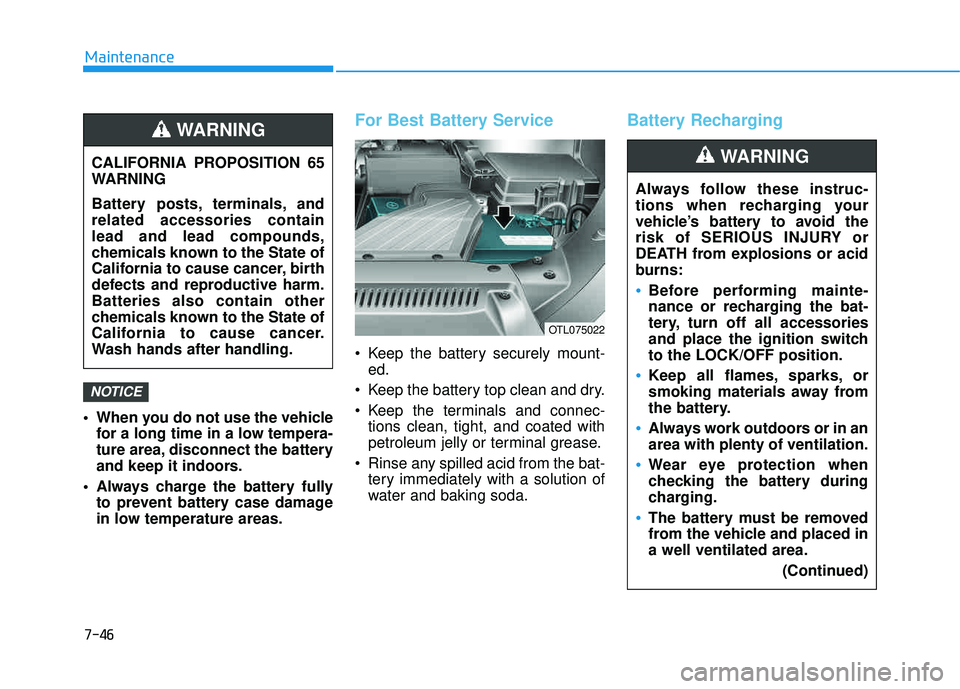
7-46
Maintenance
When you do not use the vehiclefor a long time in a low tempera-
ture area, disconnect the battery
and keep it indoors.
Always charge the battery fully to prevent battery case damage
in low temperature areas.
For Best Battery Service
Keep the battery securely mount-ed.
Keep the battery top clean and dry.
Keep the terminals and connec- tions clean, tight, and coated with
petroleum jelly or terminal grease.
Rinse any spilled acid from the bat- tery immediately with a solution of
water and baking soda.
Battery Recharging
NOTICE
CALIFORNIA PROPOSITION 65
WARNING
Battery posts, terminals, and related accessories containlead and lead compounds,
chemicals known to the State of
California to cause cancer, birth
defects and reproductive harm.Batteries also contain other
chemicals known to the State of
California to cause cancer.
Wash hands after handling.
WARNING
Always follow these instruc-
tions when recharging your
vehicle’s battery to avoid the
risk of SERIOUS INJURY or
DEATH from explosions or acid
burns:
Before performing mainte-
nance or recharging the bat-
tery, turn off all accessories
and place the ignition switchto the LOCK/OFF position.
Keep all flames, sparks, or
smoking materials away from
the battery.
Always work outdoors or in an area with plenty of ventilation.
Wear eye protection when
checking the battery during
charging.
The battery must be removed
from the vehicle and placed ina well ventilated area.
(Continued)
WARNING
OTL075022
Page 566 of 642

7-53
7
Maintenance
Compact spare tire replacement
A compact spare tire has a shorter
tread life than a regular size tire.
Replace it when you can see the
tread wear indicator bars on the tire.The replacement compact spare tire
should be the same size and design
tire as the one provided with your
new vehicle and should be mountedon the same compact spare tire
wheel. The compact spare tire is notdesigned to be mounted on a regular
size wheel, and the compact spare
tire wheel is not designed for mount-
ing a regular size tire.
Wheel Replacement
When replacing the metal wheels for
any reason, make sure the new
wheels are equivalent to the original
factory units in diameter, rim widthand offset.
Tire Traction
Tire traction can be reduced if you
drive on worn tires, tires that are
improperly inflated or on slippery
road surfaces. Tires should be
replaced when tread wear indicators
appear. To reduce the possibility of
losing control, slow down whenever
there is rain, snow or ice on the road.
(Continued)
Tires degrade over time, even
when they are not being used.
Regardless of the remaining
tread, HYUNDAI recommendsthat tires be replaced after six
(6) years of normal service.
Heat caused by hot climates or frequent high loading condi-
tions can accelerate the aging
process. Failure to follow this
warning may cause sudden
tire failure, which could lead to
a loss of vehicle control result-ing in an accident.
The original tire should be repaired or replaced as soon as
possible to avoid failure of the
spare and loss of vehicle con-
trol resulting in an accident. The
compact spare tire is for emer-
gency use only. Do not operate
your vehicle over 50 mph (80km/h) when using the compact
spare tire.
WARNING
Page 569 of 642
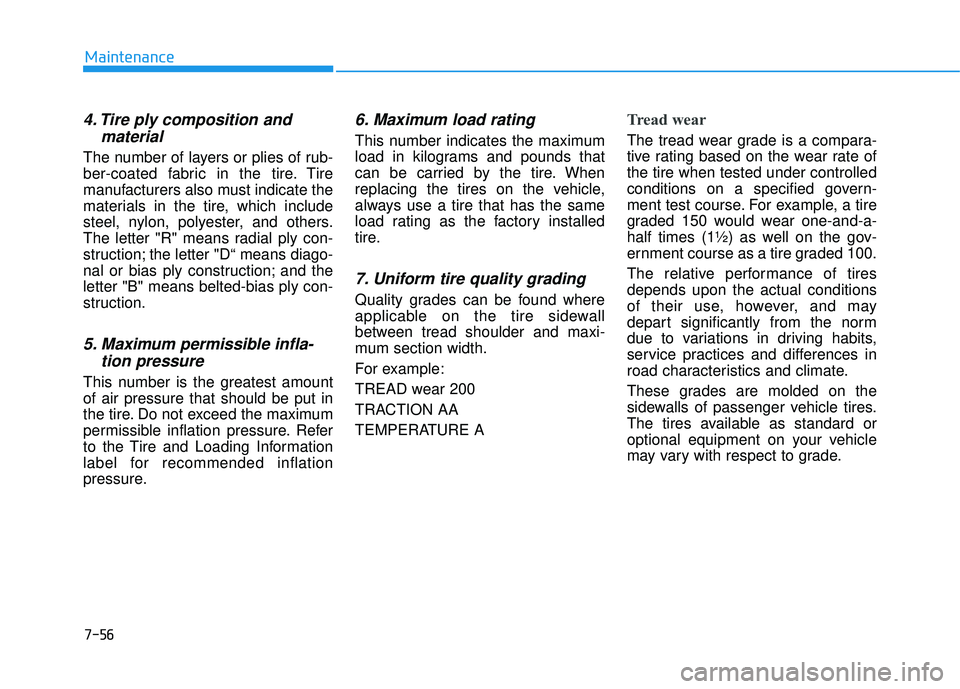
7-56
Maintenance
4. Tire ply composition andmaterial
The number of layers or plies of rub-
ber-coated fabric in the tire. Tire
manufacturers also must indicate the
materials in the tire, which include
steel, nylon, polyester, and others.
The letter "R" means radial ply con-
struction; the letter "D“ means diago-
nal or bias ply construction; and theletter "B" means belted-bias ply con-
struction.
5. Maximum permissible infla-tion pressure
This number is the greatest amountof air pressure that should be put in
the tire. Do not exceed the maximum
permissible inflation pressure. Refer
to the Tire and Loading Information
label for recommended inflation
pressure.
6. Maximum load rating
This number indicates the maximum
load in kilograms and pounds that
can be carried by the tire. When
replacing the tires on the vehicle,
always use a tire that has the same
load rating as the factory installed
tire.
7. Uniform tire quality grading
Quality grades can be found where
applicable on the tire sidewall
between tread shoulder and maxi-
mum section width.
For example:
TREAD wear 200
TRACTION AA
TEMPERATURE A
Tread wear
The tread wear grade is a compara-
tive rating based on the wear rate ofthe tire when tested under controlled
conditions on a specified govern-
ment test course. For example, a tire
graded 150 would wear one-and-a-
half times (1½) as well on the gov-
ernment course as a tire graded 100.
The relative performance of tires depends upon the actual conditions
of their use, however, and may
depart significantly from the norm
due to variations in driving habits,
service practices and differences in
road characteristics and climate.
These grades are molded on the
sidewalls of passenger vehicle tires.
The tires available as standard or
optional equipment on your vehicle
may vary with respect to grade.
Page 603 of 642
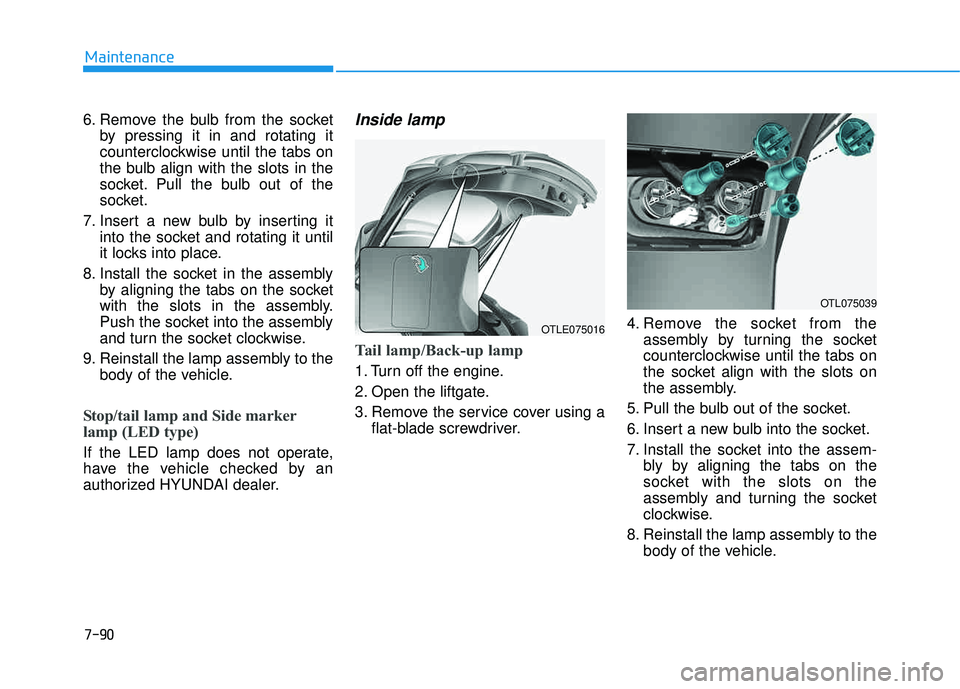
7-90
Maintenance
6. Remove the bulb from the socketby pressing it in and rotating it
counterclockwise until the tabs on
the bulb align with the slots in the
socket. Pull the bulb out of the
socket.
7. Insert a new bulb by inserting it into the socket and rotating it until
it locks into place.
8. Install the socket in the assembly by aligning the tabs on the socket
with the slots in the assembly.
Push the socket into the assembly
and turn the socket clockwise.
9. Reinstall the lamp assembly to the body of the vehicle.
Stop/tail lamp and Side marker
lamp (LED type)
If the LED lamp does not operate,
have the vehicle checked by an
authorized HYUNDAI dealer.
Inside lamp
Tail lamp/Back-up lamp
1. Turn off the engine.
2. Open the liftgate.
3. Remove the service cover using aflat-blade screwdriver. 4. Remove the socket from the
assembly by turning the socket
counterclockwise until the tabs on
the socket align with the slots on
the assembly.
5. Pull the bulb out of the socket.
6. Insert a new bulb into the socket.
7. Install the socket into the assem- bly by aligning the tabs on the
socket with the slots on the
assembly and turning the socket
clockwise.
8. Reinstall the lamp assembly to the body of the vehicle.
OTLE075016
OTL075039
Page 626 of 642
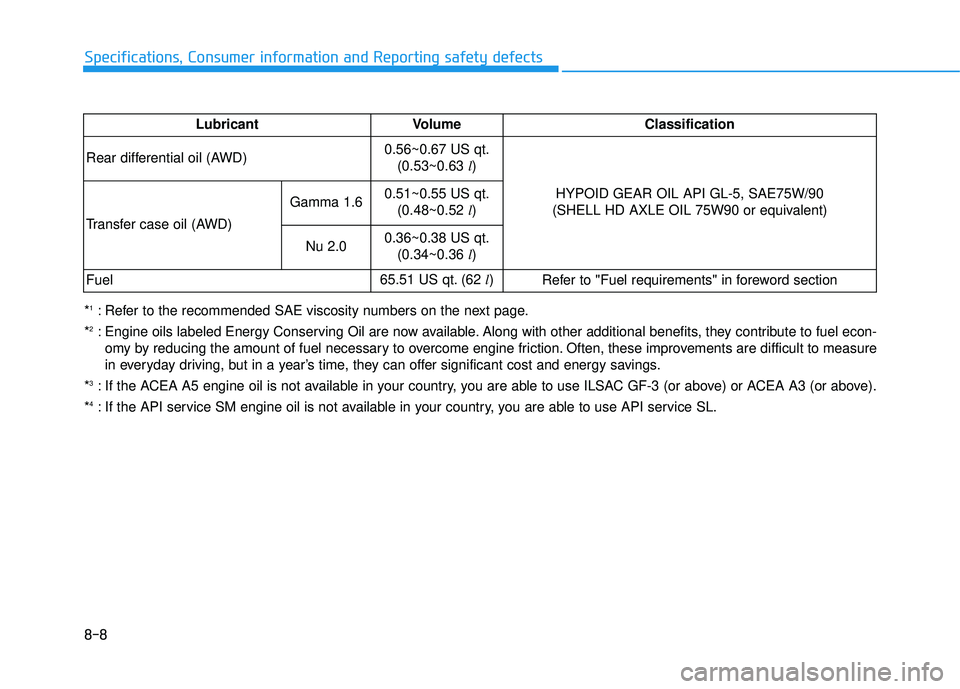
8-8
Specifications, Consumer information and Reporting safety defects
*1
: Refer to the recommended SAE viscosity numbers on the next page.
* 2
: Engine oils labeled Energy Conserving Oil are now available. Along with other additional benefits, they contribute to fuel econ -
omy by reducing the amount of fuel necessary to overcome engine friction. Often, these improvements are difficult to measure
in everyday driving, but in a year’s time, they can offer significant cost and energy savings.
* 3
: If the ACEA A5 engine oil is not available in your country, you are able to use ILSAC GF-3 (or above) or ACEA A3 (or above).
* 4
: If the API service SM engine oil is not available in your country, you are able to use API service SL. Lubricant Volume Classification
Rear differential oil (AWD) 0.56~0.67 US qt.
(0.53~0.63 l)
HYPOID GEAR OIL API GL-5, SAE75W/90
(SHELL HD AXLE OIL 75W90 or equivalent)
Transfer case oil (AWD) Gamma 1.6
0.51~0.55 US qt.
(0.48~0.52 l)
Nu 2.0 0.36~0.38 US qt.
(0.34~0.36 l)
Fuel 65.51 US qt. (62
l)
Refer to "Fuel requirements" in foreword section
Page 638 of 642
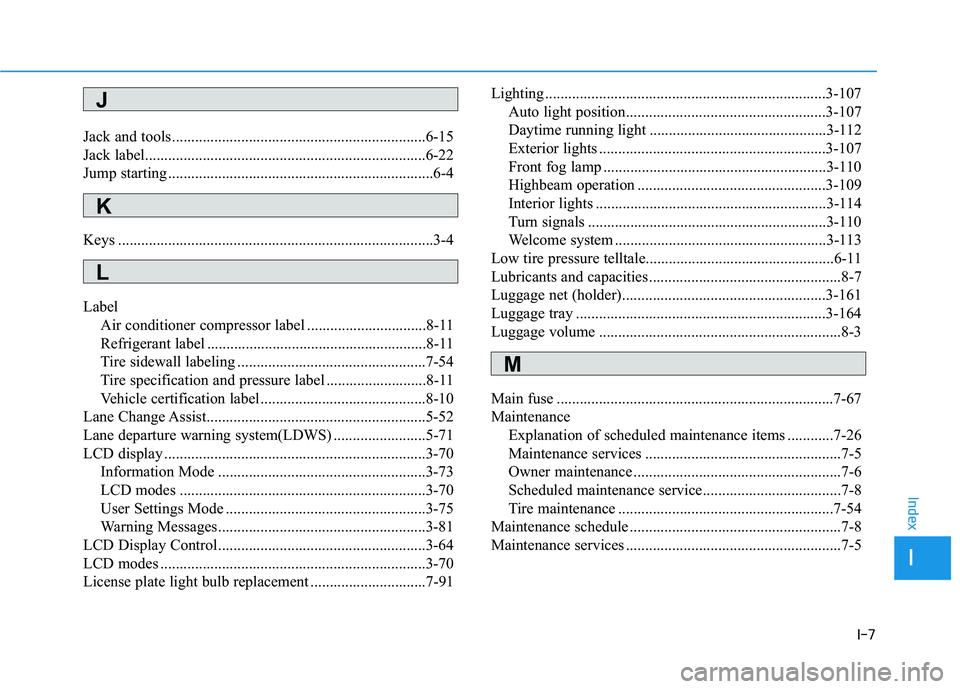
I-7
Jack and tools..................................................................6-15
Jack label.........................................................................6-22
Jump starting .....................................................................6-4
Keys ..................................................................................3-4
LabelAir conditioner compressor label ...............................8-11
Refrigerant label .........................................................8-11
Tire sidewall labeling .................................................7-54
Tire specification and pressure label ..........................8-11
Vehicle certification label ...........................................8-10
Lane Change Assist.........................................................5-52
Lane departure warning system(LDWS) ........................5-71
LCD display ....................................................................3-70 Information Mode ......................................................3-73
LCD modes ................................................................3-70
User Settings Mode ....................................................3-75
Warning Messages......................................................3-81
LCD Display Control......................................................3-64
LCD modes .....................................................................3-70
License plate light bulb replacement ..............................7-91 Lighting .........................................................................3-107
Auto light position....................................................3-107
Daytime running light ..............................................3-112
Exterior lights ...........................................................3-107
Front fog lamp ..........................................................3-110
Highbeam operation .................................................3-109
Interior lights ............................................................3-114
Turn signals ..............................................................3-110
Welcome system .......................................................3-113
Low tire pressure telltale.................................................6-11
Lubricants and capacities..................................................8-7
Luggage net (holder).....................................................3-161
Luggage tray .................................................................3-164
Luggage volume ...............................................................8-3
Main fuse ........................................................................7-67
Maintenance Explanation of scheduled maintenance items ............7-26
Maintenance services ...................................................7-5
Owner maintenance ......................................................7-6
Scheduled maintenance service....................................7-8
Tire maintenance ........................................................7-54
Maintenance schedule .......................................................7-8
Maintenance services ........................................................7-5
I
Index
L
K
M
J
Page 640 of 642
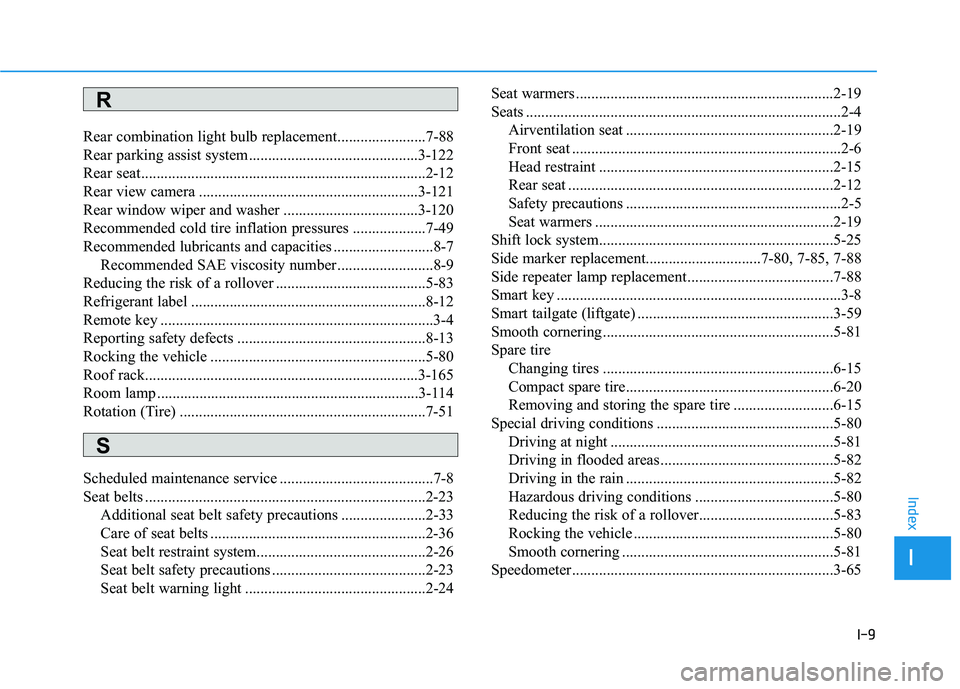
I-9
Rear combination light bulb replacement.......................7-88
Rear parking assist system............................................3-122
Rear seat..........................................................................2-12
Rear view camera .........................................................3-121
Rear window wiper and washer ...................................3-120
Recommended cold tire inflation pressures ...................7-49
Recommended lubricants and capacities ..........................8-7Recommended SAE viscosity number .........................8-9
Reducing the risk of a rollover .......................................5-83
Refrigerant label .............................................................8-12
Remote key .......................................................................3-4
Reporting safety defects .................................................8-13
Rocking the vehicle ........................................................5-80
Roof rack.......................................................................3-165
Room lamp ....................................................................3-114
Rotation (Tire) ................................................................7-51
Scheduled maintenance service ........................................7-8
Seat belts .........................................................................2-23
Additional seat belt safety precautions ......................2-33
Care of seat belts ........................................................2-36
Seat belt restraint system............................................2-26
Seat belt safety precautions ........................................2-23
Seat belt warning light ...............................................2-24 Seat warmers ...................................................................2-19
Seats ..................................................................................2-4
Airventilation seat ......................................................2-19
Front seat ......................................................................2-6
Head restraint .............................................................2-15
Rear seat .....................................................................2-12
Safety precautions ........................................................2-5
Seat warmers ..............................................................2-19
Shift lock system.............................................................5-25
Side marker replacement..............................7-80, 7-85, 7-88
Side repeater lamp replacement ......................................7-88
Smart key ..........................................................................3-8
Smart tailgate (liftgate) ...................................................3-59
Smooth cornering............................................................5-81
Spare tire Changing tires ............................................................6-15
Compact spare tire......................................................6-20
Removing and storing the spare tire ..........................6-15
Special driving conditions ..............................................5-80
Driving at night ..........................................................5-81
Driving in flooded areas .............................................5-82
Driving in the rain ......................................................5-82
Hazardous driving conditions ....................................5-80
Reducing the risk of a rollover...................................5-83
Rocking the vehicle ....................................................5-80
Smooth cornering .......................................................5-81
Speedometer....................................................................3-65
I
Index
R
S